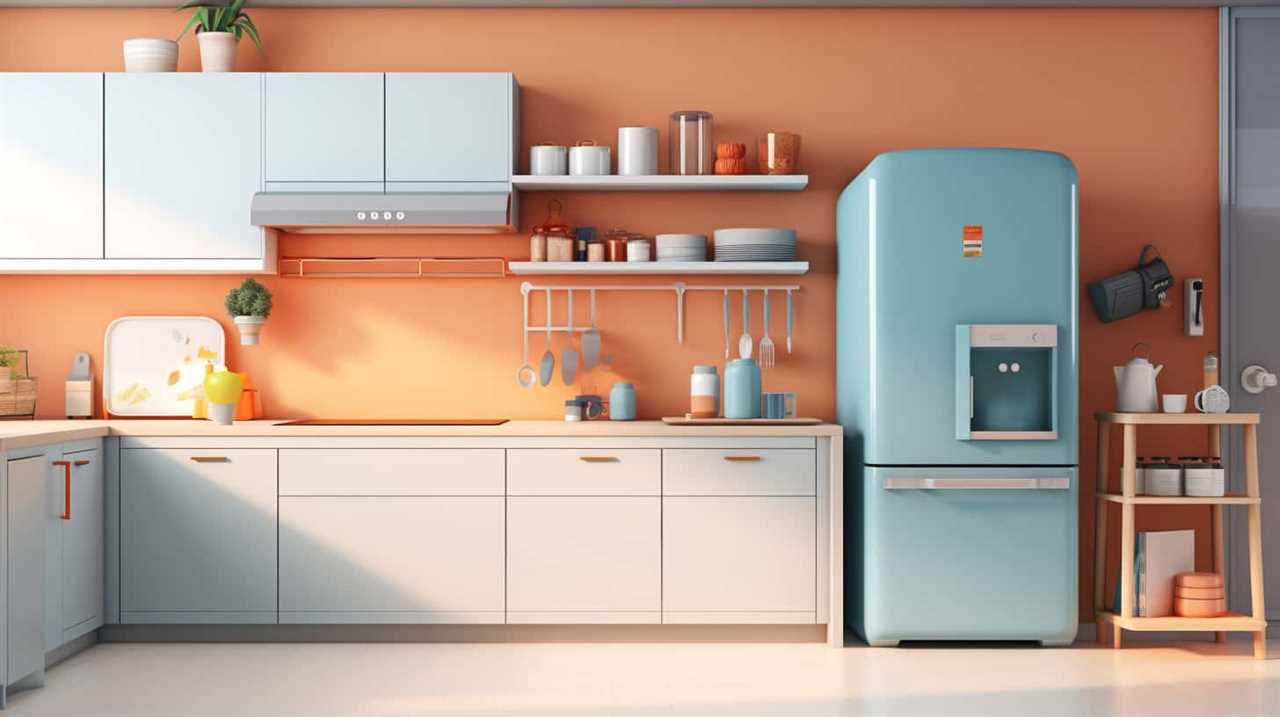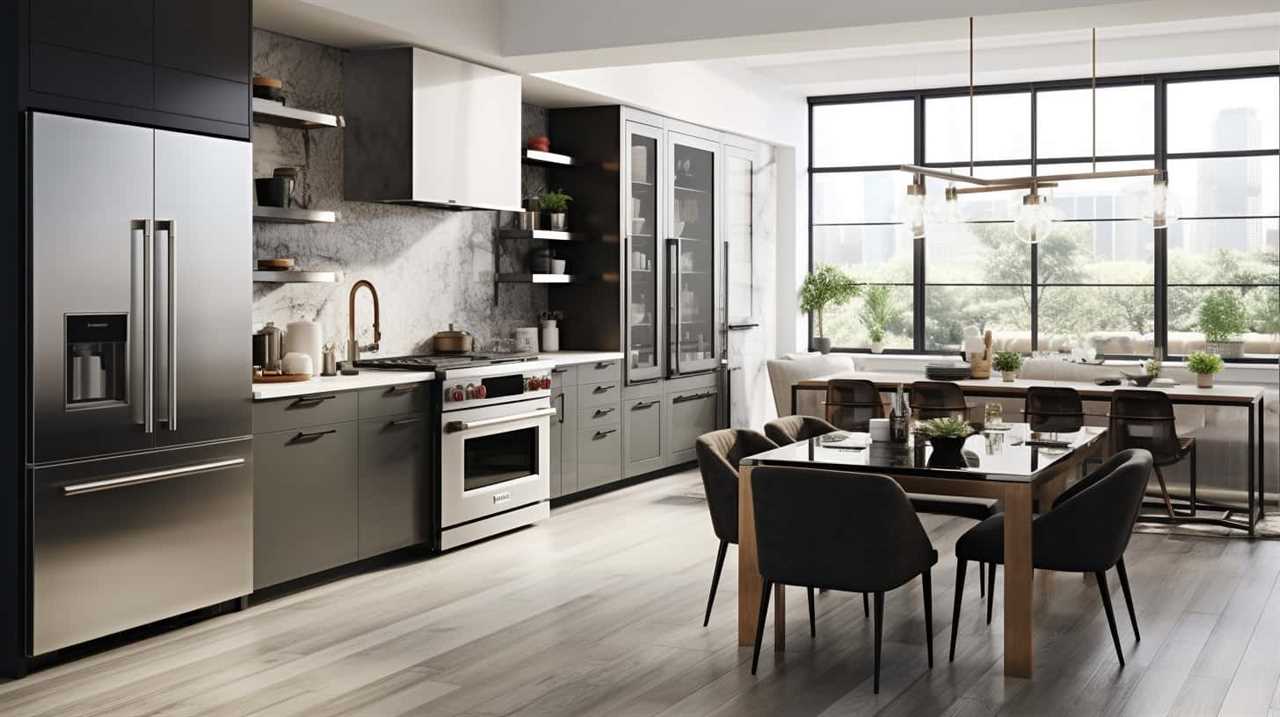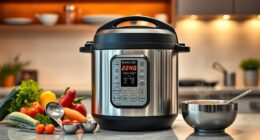At our company, we recognize the significance of adhering to appliance safety standards and regulations. Whether you are a manufacturer, retailer, or consumer, following these standards is essential for guaranteeing appliance safety.
For instance, imagine a scenario where a faulty microwave malfunctions and causes a fire in someone’s kitchen. By understanding and adhering to the relevant safety standards and regulations, such accidents can be minimized or even prevented.
In this guide, we will provide you with a comprehensive overview of appliance safety standards and regulations. We will explore key organizations that set these standards, identify common hazards in appliances, discuss safety testing and certification processes, and provide guidelines for appliance maintenance and inspection.
By the end, you will have the knowledge and tools needed to navigate the complex world of appliance safety with confidence.

Key Takeaways
- Compliance with safety standards is crucial for ensuring the safety of appliances.
- Manufacturers must adapt to evolving technology to meet regulations.
- Leading safety organizations like IEC, UL, and CPSC play a crucial role in ensuring appliance safety.
- Regular monitoring, adherence to safety standards, and thorough inspections minimize the need for product recalls.
Importance of Appliance Safety Standards
We firmly believe that understanding and adhering to appliance safety standards is crucial for ensuring the well-being of consumers. As manufacturers and suppliers, it’s our responsibility to prioritize the safety of our products and build consumer trust. This is where the role of government comes into play.
Government agencies, such as the Consumer Product Safety Commission (CPSC), play a vital role in establishing and enforcing appliance safety standards. They conduct rigorous testing and inspections to ensure that appliances meet safety requirements before reaching the market.
Appliance safety standards set by the government serve as a benchmark for manufacturers to design and produce appliances that are safe to use. These standards cover various aspects, including electrical safety, fire safety, and mechanical safety. By complying with these standards, manufacturers can minimize the risks associated with their appliances and provide consumers with peace of mind.
Consumer trust is a crucial factor in the success of any business. When consumers trust that the appliances they purchase are safe to use, they’re more likely to make repeat purchases and recommend the brand to others. Adhering to appliance safety standards demonstrates our commitment to consumer well-being and helps build trust in our brand.

Overview of Appliance Regulations
When it comes to appliance regulations, there are several common safety requirements that must be met. However, complying with these regulations can present challenges for manufacturers.
In this section, we’ll explore these common safety requirements and discuss potential solutions to help manufacturers ensure compliance with appliance regulations.
Common Safety Requirements
Before diving into the details of appliance regulations, let’s first familiarize ourselves with the common safety requirements that manufacturers must adhere to. These requirements serve as the foundation for ensuring the safety of appliances and protecting consumers from potential hazards.
Common safety requirements encompass various aspects, including electrical safety, mechanical safety, and material safety. Manufacturers must comply with international standards and regulations, such as the International Electrotechnical Commission (IEC) standards and the European Union’s (EU) directives.

Challenges in compliance arise from the need to meet these standards while still maintaining cost efficiency and product competitiveness. Manufacturers must also keep up with the evolving nature of technology and adapt their appliances accordingly.
Compliance Challenges and Solutions
Continuing our exploration of appliance safety requirements, let’s now delve into the compliance challenges and solutions associated with appliance regulations.
In order to ensure compliance with these regulations, manufacturers must develop effective compliance strategies to meet industry challenges. Here are three key compliance challenges and their corresponding solutions:
- Regulatory Complexity:
- Challenge: Keeping up with evolving and complex regulations across different jurisdictions.
- Solution: Establish a dedicated team to monitor and interpret regulatory changes, and implement robust compliance management systems.
- Testing and Certification:
- Challenge: Meeting the rigorous testing and certification requirements for appliances.
- Solution: Work closely with accredited testing laboratories and certification bodies to ensure compliance and obtain necessary certifications.
- Supply Chain Management:
- Challenge: Ensuring compliance throughout the entire supply chain, including component suppliers.
- Solution: Implement a comprehensive supplier qualification and monitoring program, conduct regular audits, and establish clear contractual requirements for compliance.
Key Organizations Setting Safety Standards
As we delve into the topic of key organizations setting safety standards, it’s important to understand the leading safety organizations that play a crucial role in ensuring the safety of appliances.

These organizations develop and enforce compliance requirements that manufacturers must adhere to in order to meet industry-wide safety guidelines. By keeping up with the standards set by these organizations, we can ensure that appliances meet the necessary safety regulations and provide consumers with peace of mind.
Leading Safety Organizations
To fully understand appliance safety standards and regulations, we must familiarize ourselves with the leading safety organizations that set these standards. These organizations play a crucial role in ensuring the safety of appliances worldwide and developing global regulations.
Here are three key organizations that are at the forefront of setting safety standards:
- International Electrotechnical Commission (IEC): The IEC is a leading organization that develops and publishes international standards for electrical and electronic equipment. Their standards cover a wide range of appliances and aim to ensure their safety, performance, and compatibility.
- Underwriters Laboratories (UL): UL is a globally recognized safety certification organization that tests and certifies appliances to ensure they meet the required safety standards. Their certifications provide assurance to consumers that the appliances they purchase have undergone rigorous testing.
- International Organization for Standardization (ISO): ISO develops and publishes international standards that cover various aspects of appliance safety, including design, testing, and performance. Their standards are widely adopted and help ensure consistent safety practices across different countries.
Compliance Requirements Overview
Now let’s delve into the compliance requirements overview provided by the key organizations setting safety standards.

When it comes to compliance challenges in appliance safety, it’s crucial to understand the role of these organizations in ensuring consumer protection.
The International Electrotechnical Commission (IEC) is one such organization that establishes international safety standards for electrical appliances. Their guidelines cover aspects like electrical safety, mechanical hazards, and product labeling.
Similarly, the Underwriters Laboratories (UL) sets safety standards for North America and tests appliances to ensure compliance.
In Europe, the European Committee for Electrotechnical Standardization (CENELEC) and the European Union’s Low Voltage Directive (LVD) play a significant role in setting safety requirements.

Industry-Wide Safety Guidelines
Let’s continue our discussion by exploring the industry-wide safety guidelines established by key organizations setting safety standards. These guidelines are the result of industry-wide collaboration and aim to ensure global safety standards are met.
Here are three key organizations that play a crucial role in setting these guidelines:
- International Electrotechnical Commission (IEC): The IEC develops and publishes international standards for electrical, electronic, and related technologies. Their standards cover a wide range of aspects, including product safety, testing methods, and performance requirements.
- Underwriters Laboratories (UL): UL is a global safety certification company that sets standards for product safety and performance. Their guidelines are widely recognized and used by manufacturers, regulatory bodies, and consumers worldwide.
- European Committee for Electrotechnical Standardization (CENELEC): CENELEC is responsible for developing European standards for electrical and electronic products. Their guidelines ensure the safety, compatibility, and interoperability of appliances in the European market.
Common Hazards in Appliances
Our focus will now shift to the identification and mitigation of prevalent hazards found in appliances.
When it comes to energy efficiency, appliances that aren’t properly designed or maintained can pose significant hazards. For example, appliances with faulty electrical components or poor insulation may consume excessive energy, leading to overheating and potential fire hazards. It’s crucial to ensure that appliances are designed and manufactured to meet energy efficiency standards to mitigate these risks.

Another common hazard in appliances is the potential for product recalls. Faulty design, manufacturing defects, or inadequate quality control can result in appliances that pose safety risks to consumers. These risks could include electric shocks, fires, or even explosions. Regular monitoring and adherence to safety standards can help identify potential hazards early on and minimize the need for product recalls.
In order to ensure the safety of appliances, rigorous safety testing and certification processes must be implemented. These processes involve comprehensive evaluations of various aspects, including electrical safety, mechanical stability, and thermal performance. By subjecting appliances to these tests, manufacturers can identify and rectify any potential hazards before the products reach consumers.
As we delve into the realm of safety testing and certification processes, we’ll explore the specific procedures and standards that ensure appliances meet the necessary safety requirements.
Safety Testing and Certification Processes
To ensure the safety of appliances, we must understand the rigorous safety testing and certification processes involved. These processes are critical in identifying potential hazards and ensuring that appliances meet the necessary safety standards. Here are three key aspects of the safety testing and certification processes:

- Safety Testing Process:
- The safety testing process involves subjecting appliances to a series of tests to assess their performance and safety features.
- These tests include electrical safety, mechanical safety, thermal safety, and performance testing.
- Each test is conducted in accordance with specific standards and regulations to ensure consistency and accuracy.
- Certification Challenges:
- Obtaining certifications can be challenging due to the complexity of safety requirements and the evolving nature of technology.
- Manufacturers face the challenge of staying updated with the latest safety standards and ensuring compliance.
- Additionally, the certification process involves extensive documentation and thorough inspections to demonstrate compliance with safety regulations.
- International Harmonization:
- To facilitate global trade, there’s a growing effort to harmonize safety standards and certification processes internationally.
- This harmonization aims to eliminate duplicative testing and certification requirements, reducing costs and promoting efficiency.
- Manufacturers should stay informed about international standards and work towards obtaining global certifications to expand their market reach.
Understanding the safety testing process and overcoming certification challenges are crucial steps in ensuring that appliances meet the highest safety standards. By adhering to these processes, manufacturers can instill confidence in consumers and promote the safe use of appliances.
Compliance Requirements for Manufacturers
In order to ensure compliance with safety standards and regulations, manufacturers must adhere to specific requirements. These requirements are put in place to address compliance challenges and ensure consumer protection measures are met.
Manufacturers must first conduct thorough risk assessments on their appliances to identify potential hazards. They must then design and manufacture their products to meet the applicable safety standards and regulations. This includes using appropriate materials, ensuring proper insulation and grounding, and incorporating safety features such as temperature control and overload protection.
Additionally, manufacturers must provide clear and comprehensive instructions for the safe installation, operation, and maintenance of their appliances. They must also conduct regular testing and quality control checks to ensure ongoing compliance.

To further demonstrate compliance, manufacturers may be required to obtain certifications or marks of conformity from recognized testing laboratories or certification bodies. These certifications provide assurance to consumers that the appliances have met the necessary safety requirements.
Compliance with safety standards and regulations is crucial for manufacturers to protect consumers and avoid legal and financial consequences. By adhering to these compliance requirements, manufacturers can ensure the safety and reliability of their appliances, contributing to a safer and more secure marketplace for consumers.
Responsibilities of Retailers and Distributors
As retailers and distributors, we have important legal obligations when it comes to appliance safety standards and regulations. It’s our responsibility to ensure that the products we sell comply with all applicable requirements and regulations.
This includes verifying that the appliances we distribute meet the necessary safety standards to protect consumers.

Retailer’s Legal Obligations
Our legal obligations as retailers and distributors include ensuring the safety of all appliances sold to consumers. As retailers, we’ve a responsibility to protect consumers from any harm that may arise from using the appliances purchased from us. This includes complying with all applicable safety standards and regulations, as well as continuously monitoring and assessing the safety of the products we sell.
To fulfill our retailer’s liability and ensure consumer protection, we must:
- Provide clear and accurate product information, including any potential risks or hazards associated with the appliances.
- Conduct regular quality control checks to ensure that the appliances meet safety standards before they’re sold.
- Promptly respond to any safety concerns or complaints raised by consumers and take appropriate action to address them.
Distributor’s Compliance Requirements
To ensure compliance with distributor’s responsibilities, we must adhere to the required safety standards and regulations for selling appliances. Distributors play a crucial role in consumer protection by ensuring that the appliances they distribute meet all necessary safety requirements.
However, they also face certain challenges when it comes to compliance. One of the main challenges is keeping up with the constantly evolving safety standards and regulations. Distributors must stay updated on any changes or new requirements to ensure that the appliances they distribute meet the highest safety standards.

Additionally, distributors must also ensure that the appliances they distribute are properly labeled and have clear instructions for safe use. By fulfilling these responsibilities, distributors can help protect consumers and maintain compliance with the necessary regulations.
Ensuring Consumer Protection
Ensuring consumer protection involves prioritizing the fulfillment of retailers and distributors’ responsibilities. To achieve this, retailers and distributors must focus on consumer education and regulatory compliance. Here are three key aspects that they need to consider:
- Providing comprehensive product information: Retailers and distributors have a responsibility to educate consumers about the potential risks associated with using appliances. This includes providing clear and accurate information about product features, proper usage, and maintenance requirements.
- Ensuring regulatory compliance: Retailers and distributors must ensure that the appliances they sell comply with all relevant safety standards and regulations. This involves conducting thorough testing and certification processes to guarantee the safety and quality of the products they offer.
- Offering reliable customer support: Retailers and distributors should have effective customer support systems in place to address consumer concerns and provide assistance when needed. This includes promptly handling product recalls, repairs, and replacements to ensure consumer satisfaction and safety.
By fulfilling these responsibilities, retailers and distributors contribute to consumer protection and promote a safer marketplace.
Transitioning into the subsequent section about consumer rights and safety awareness, it’s essential to understand how these aspects align with the overall goal of ensuring a safe and informed consumer base.

Consumer Rights and Safety Awareness
Consumers possess the right to be informed about safety standards and regulations regarding appliances. Consumer education plays a crucial role in ensuring that individuals are aware of their rights and the potential risks associated with using certain appliances. It’s important for consumers to stay informed about the latest safety standards and regulations to make informed decisions when purchasing and using appliances.
One key aspect of consumer rights and safety awareness is understanding product recalls. When a manufacturer identifies a safety issue with their appliance, they may initiate a recall to protect consumers from potential harm. Consumers should actively stay informed about product recalls and take appropriate action if they own a recalled appliance. This can involve contacting the manufacturer or retailer for a repair, replacement, or refund, depending on the recall instructions.
Safety Labels and Warning Signs
As consumers, we can stay informed about safety standards and regulations by paying attention to the safety labels and warning signs on appliances. Safety label standards and warning sign regulations play a crucial role in ensuring the safe operation of appliances. Here are three important aspects to consider:
- Safety label standards: Safety labels provide vital information about potential hazards and instructions for safe use. These labels must adhere to specific standards to ensure clarity and effectiveness. Standards dictate the size, color, font, and placement of safety labels, making them easily visible and understandable to users. Following these standards ensures that consumers are aware of any potential risks associated with the appliance.
- Warning sign regulations: Warning signs are designed to alert users about specific dangers or precautions. Regulations govern the content, design, and placement of warning signs to ensure consistency and effectiveness. These regulations mandate the use of universally recognized symbols or pictograms, ensuring that the warning signs can be easily understood by a wide range of users, regardless of language or literacy level.
- Importance of compliance: Adhering to safety label standards and warning sign regulations is crucial for manufacturers to demonstrate their commitment to consumer safety. Compliance ensures that appliances are equipped with clear and informative labels and signs, reducing the risk of accidents or injuries. It also fosters trust between consumers and manufacturers, as consumers can rely on the fact that the appliance meets the necessary safety requirements.
Appliance Maintenance and Inspection Guidelines
To maintain the safety and proper functioning of appliances, we need to follow appliance maintenance and inspection guidelines. Regular inspections are crucial in identifying potential issues and preventing accidents. Here are some appliance repair tips and the importance of regular inspections:

| Appliance Repair Tips | Importance of Regular Inspections |
|---|---|
| Clean appliances regularly to remove dirt and debris. | Regular inspections can detect any loose or damaged parts, preventing further damage or potential hazards. |
| Check for any signs of wear and tear, such as frayed wires or cracked cords. | Inspections ensure that appliances are in compliance with safety standards and regulations. |
| Follow the manufacturer’s maintenance instructions for each appliance. | Regular maintenance prolongs the lifespan of appliances and reduces the risk of malfunctions. |
| Test safety features regularly, such as the smoke detector on a stove. | Inspections provide peace of mind, knowing that appliances are functioning properly and are safe to use. |
Emerging Trends in Appliance Safety Standards
We, as industry professionals, are witnessing a rise in the adoption of new technologies and advancements in appliance safety standards. The impact of emerging technology on appliance safety can’t be overstated.
Here are some key trends that are shaping the future of appliance safety standards:
- Integration of Internet of Things (IoT): With the increasing prevalence of IoT devices, appliances are now being connected to the internet, allowing for real-time monitoring and control. This enables proactive safety measures such as automatic shutdown in case of emergencies.
- Advanced sensors and machine learning: Appliance safety technologies are now incorporating advanced sensors and machine learning algorithms to detect potential hazards and take preventive actions. For example, fire detection systems can use machine learning to identify smoke patterns and trigger alarms.
- Enhanced communication protocols: The development of robust communication protocols, such as Bluetooth Low Energy (BLE) and Zigbee, ensures reliable and secure communication between appliances and safety devices. This enables seamless integration of safety features across different appliances in a household.
These emerging trends in appliance safety standards are revolutionizing the way we ensure the safety of our appliances. As industry professionals, it’s crucial to stay updated with these advancements to effectively navigate the dynamic landscape of appliance safety.
Frequently Asked Questions
Are There Any Penalties for Manufacturers Who Do Not Comply With Appliance Safety Standards?
There are penalties for manufacturers who don’t comply with appliance safety standards. Non-compliance can result in severe consequences for manufacturers, including fines, legal action, and damage to their reputation.

It’s crucial for manufacturers to adhere to safety standards to ensure the well-being of consumers and maintain trust in their products. By mastering appliance safety standards and regulations, manufacturers can avoid these penalties and create safer appliances for the market.
How Often Should Appliances Be Inspected for Safety?
Appliances, like any machinery, require regular inspections to ensure their safety. The frequency of these inspections depends on the type of appliance and its usage. Regular maintenance is crucial in order to identify any potential issues and address them before they become a hazard.
Can Retailers Be Held Liable for Selling Appliances That Are Not Compliant With Safety Standards?
Yes, retailers can be held liable for selling appliances that aren’t compliant with safety standards. This is an important aspect of consumer protection.
When retailers sell appliances that don’t meet safety standards, they put consumers at risk of accidents and injuries. Therefore, it’s crucial for retailers to ensure that the appliances they sell meet all necessary safety regulations.

This will help protect consumers and prevent potential legal consequences for the retailers.
What Should Consumers Do if They Suspect an Appliance They Own Is Not Safe?
If consumers suspect that an appliance they own isn’t safe, they should take immediate action to protect themselves and others.
Reporting concerns to the appropriate authorities is crucial. This could include contacting the manufacturer, retailer, or relevant regulatory agencies.
Consumers have the right to expect safe and compliant appliances, and it’s important to assert these rights.

Are There Specific Safety Standards for Appliances Used in Commercial Settings?
Yes, there are specific safety standards for appliances used in commercial settings.
These regulations ensure that commercial appliances meet certain safety requirements to protect both workers and consumers.
Failure to comply with these standards can result in severe penalties, including fines and legal consequences.
It’s crucial for businesses to understand and adhere to these regulations to ensure the safety of their employees and customers, as well as to avoid any potential legal issues.

Conclusion
In conclusion, mastering appliance safety standards and regulations is of paramount importance to ensure the well-being of consumers. By understanding the overview of appliance regulations, key organizations setting safety standards, and the common hazards in appliances, individuals can make informed decisions.
Safety testing, certification processes, and consumer rights play a crucial role in maintaining appliance safety. With the help of safety labels, warning signs, and regular maintenance and inspection, individuals can mitigate risks.
As emerging trends continue to shape appliance safety standards, staying informed is crucial to safeguarding lives and property.










